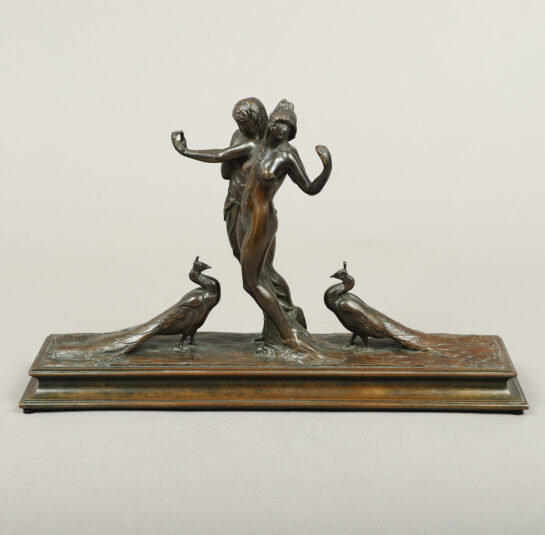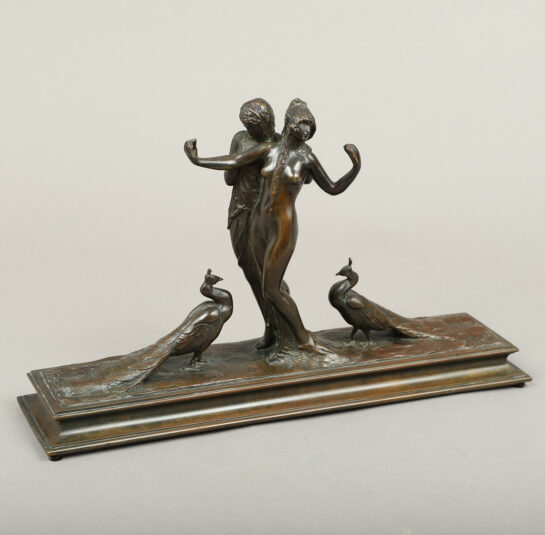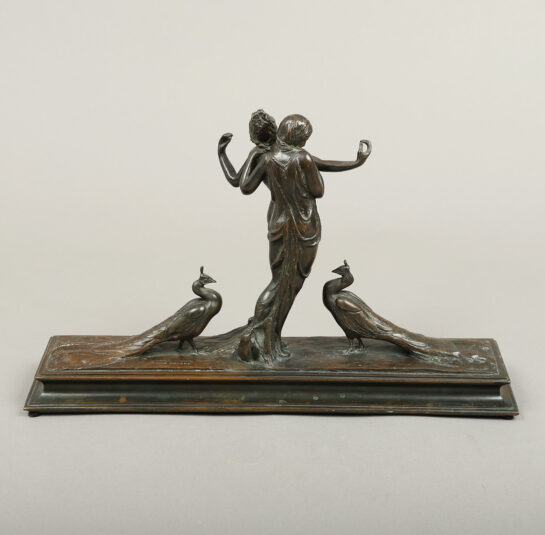Mario Korbel (1882-1954) Lived/active: New York, Illinois/France and Germany
Classical Woman Flanked by Peacocks. Signed/stamped: Mario Korbel, Gorham Co. Founders/QAPB (on base). Ca. 1925. Bronze. Excellent condition, wonderful patina.
Provenance: James Graham Gallery, New York. Thomas Armstrong III by descent to Whitney ‘Bunty” Brewster Armstrong.
Thomas N. Armstrong III was an American museum curator and collector who was director emeritus of the Abby Aldrich Rockefeller Folk Art Museum, the Pennsylvania Academy of the Fine Arts, the Whitney Museum of American Art, and the Andy Warhol Museum. He was also a board member of the New York School of Interior Design. Armstrong died in 2011 at the age of 78. He and his wife “Bunty”, who died in 2022 at the age of 84, were long time supporters of The Garden Conservancy of which Mr. Armstrong, who created a three-acre garden at their country home at Fishers Island, New York, became chairman in 2007. Mrs. Armstrong was active as a member of The River Club and The Cosmopolitan Club, a long-time sustaining member of the New York Junior League, a long-time board member of the Women’s Prison Association, and head of the Ladies Committee of the National Horse Show.
This rare and important work by Mario Korbel exemplified his talent as a master sculptor. His classical works often depicted idealized female nudes and dancers. Born in Czechoslovakia, he moved to the States at age 18.
Mario Josef Korbel was born in 1882, in Oslik, Bohemia (now part of the Czech Republic). His early education was in a Pietist Protestant sect, the Moravian Church that originated in Bohemia in the 1400s. Though Mario showed an interest and talent for art at an early age, his father, Josef Korbel, a church member, refused to allow his son to pursue art as a career. However, his mother, Katherine Dolezal, who was a Catholic, arranged for him to model ornamental sculpture.(1)
Korbel moved to New York and then to Chicago, where he took a position at Kunst and Pfaffke modeling ornamental interior moldings. In 1905 he returned to Europe to study, first in Berlin and then at the Royal Academy of Fine Arts in Munich, where he studied for three years. Korbel attended the Académie Julian in Paris, where he showed his work at a 1909 Salon exhibition.(2)
After returning to Chicago the following year, Korbel was asked to design a monument to commemorate a Bohemian patriot in the city of Racine, Wisconsin. He was also commissioned to sculpt several portraits and other public and private commissions in Chicago, St. Louis, Denver, and other Western cities. (3) Early in his career, Korbel embraced the classical traditions in art, especially the simpler forms of early Greek sculpture that French sculptor August Rodin (1840-1917) and others exemplified at the end of the nineteenth century. Katherine Solender noted that Korbel’s “classical sense of order and proportion, as well as his intimate sensitivity to the decorative quality of line” won him commercial success.(4)
One of his most well-known classical works, Andante (dated 1926), was cast in a series of seven statuettes and in two larger versions, and versions are now in the New York Metropolitan Museum and the Detroit Institute of the Arts. Andante is composed of two figures that personify the elegance and cadence of slow, ritualistic dance. The artist favored this subject matter in several other sculptures and sculptural groups. Genthe refers to a figural work entitled The Dancer, a voluptuous nude posed on one foot, her arms flung forward. The model for this work, a woman named Hilda Beyer, became Korbel’s love interest and modeled for many of his works.(5) They were later married, but divorced in 1924.
Source: Askart: Biography from The Columbus Museum of Art, Georgia
Footnotes:
1. Arnold Genthe, “The Work of Mario Korbel and Walter D. Goldbeck”, International Studio 57 (November 1915), xix.
2. Janis Conner and Joel Rosenkrantz, Rediscoveries in American Sculpture: Studio Works 1893-1939, (Austin, Texas: University of Texas Press, 1989), 95-104.
3. Genthe, xix.
4. Katherine Solender, “Mario Korbel”, The American Way of Sculpture, 1890-1930, exhibition catalogue (Cleveland: Cleveland Museum of Art, 1986), 36.
5. Genthe, xx.
Dimensions: 10 ¼”h, 17”w, 4 ½”d
Item ID: DA-SO 294
Price: $22000





